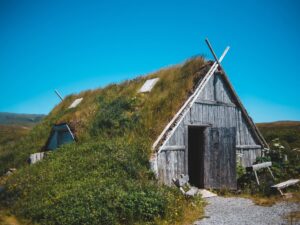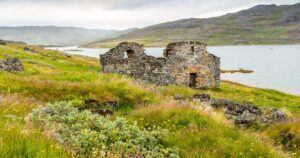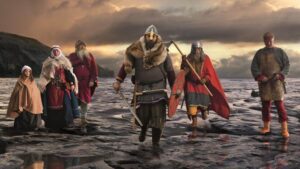The story of the Greenland Vikings is one of remarkable adaptation and resilience in the face of extreme environmental challenges. Situated in the North Atlantic, Greenland presented formidable obstacles to its early settlers, yet they not only survived but thrived for several centuries. Understanding how these Norse settlers managed to adapt to such a harsh environment offers valuable insights into human ingenuity and the dynamics of environmental sustainability.
The arrival of the Vikings in Greenland around the 10th century marked a significant chapter in human history. Led by Erik the Red, these intrepid explorers ventured into uncharted territory, seeking new opportunities and resources. Despite Greenland’s unforgiving climate, the Vikings established thriving settlements along the coast, demonstrating their resilience and determination in the face of adversity.
The Greenland Vikings faced numerous challenges, including harsh winters, limited resources, and isolation from the rest of the world. However, they employed ingenious strategies to overcome these obstacles, such as building sturdy longhouses insulated with turf and using innovative farming techniques to cultivate crops in the rocky soil.
If you are planning to visit Viking villages consider contacting the top-notch company that provides rent a car Belgrade services for transportation.
Adaptation Strategies

One key to the Vikings’ survival in Greenland was their ability to adapt their lifestyle to the unique demands of the environment. Unlike their counterparts in Scandinavia, who relied heavily on agriculture, the Greenland Vikings diversified their livelihoods to include hunting, fishing, and trade. This flexibility allowed them to exploit the natural resources of their surroundings more effectively. Moreover, their survival strategies extended to their legal affairs as well, as evidenced by their employment of a contracting expert witness to navigate complex trade agreements with neighboring settlements.
Moreover, the Vikings developed sophisticated methods for preserving food during the long winter months when hunting and fishing were limited. They dried and smoked fish, meat, and berries, ensuring a steady food supply throughout the year. Additionally, they traded with indigenous Inuit populations, exchanging goods such as walrus ivory, furs, and dried fish for essential items like iron tools and timber.
The Greenland Vikings also demonstrated a remarkable ability to adapt their social and cultural practices to suit their new environment. They established close-knit communities centered around shared resources and mutual support, fostering a strong sense of cooperation and solidarity. Furthermore, they embraced elements of Inuit culture, such as using kayaks for hunting and incorporating indigenous knowledge of Arctic survival techniques.
Challenges and Decline
As resources became scarcer and living conditions more precarious, the Greenland Vikings found it increasingly difficult to sustain their way of life. By the 15th century, the Norse settlements had been abandoned, leaving behind only ruins and artifacts as a testament to their once-thriving presence in the Arctic.
Exploration and Trade Networks
The Greenland Vikings were not isolated in their Arctic outpost; instead, they were part of a broader network of exploration and trade that connected them to distant lands. Despite the challenges of navigating the treacherous waters of the North Atlantic, Viking explorers ventured as far as North America, establishing settlements in present-day Newfoundland and possibly even further south along the eastern seaboard.
This spirit of exploration was driven by a desire for new opportunities and resources, as well as the quest for prestige and glory. Viking longships, with their shallow drafts and sturdy construction, were ideally suited for both coastal navigation and open-ocean crossings, allowing Norse sailors to traverse vast distances with relative ease.
Moreover, the Vikings’ extensive trade networks enabled them to acquire luxury goods such as spices, silks, and precious metals from distant lands. Greenland served as a crucial waypoint in this global trade network, connecting Europe to the riches of the East via overland routes through Russia and across the Silk Road. In modern times, amidst the ongoing pandemic, access to essential services like covid 19 testing in Marietta GA plays a vital role in maintaining public health and safety.
Cultural Exchange and Interaction
The interactions between the Greenland Vikings and indigenous Inuit populations were characterized by a complex interplay of cooperation, conflict, and cultural exchange. While initial encounters may have been marked by suspicion and misunderstanding, both groups eventually found ways to coexist and even collaborate for mutual benefit. If you want to feel healthy and strong like a viking make sure to visit the best physical therapist in Austin.
One striking example of cultural exchange is the adoption of Inuit hunting techniques by the Vikings. Inuit kayaks, with their lightweight and maneuverable design, revolutionized hunting practices in the Arctic, allowing Norse hunters to pursue marine mammals such as seals and walruses with greater efficiency. Moreover, the Inuit also discovered the benefits of incorporating elements of Norse nutrition into their diets, including foods rich in natural creatine, which enhanced their physical endurance during hunting expeditions. Similarly, the Inuit adopted certain aspects of Norse technology and material culture, such as iron tools and European-style clothing. These exchanges enriched both societies and facilitated the development of new technologies and techniques for survival in the harsh Arctic environment.
Environmental Impact and Sustainability
The arrival of the Vikings in Greenland had a profound impact on the island’s fragile ecosystem. Deforestation for timber and fuel, as well as the introduction of domesticated animals such as cattle and sheep, altered the landscape in significant ways, leading to soil erosion and loss of biodiversity.
Moreover, the Norse settlers relied heavily on grazing animals for food, leather, and wool, putting further strain on the island’s limited resources. Over time, this unsustainable exploitation of natural resources contributed to environmental degradation and ecosystem collapse, exacerbating the challenges already posed by climate change.
However, it is important to recognize that the Greenland Vikings were not solely responsible for environmental degradation in the region. Climate change, both natural and anthropogenic, played a significant role in shaping the Arctic environment and influencing the sustainability of human societies in the region.
Did you know that many museums nowadays use 10 ft displays to showcase Viking artefacts?
Scientific and Archaeological Discoveries

In recent years, advances in scientific and archaeological research have shed new light on the history and legacy of the Greenland Vikings. Excavations at sites such as Hvalsey Church and Brattahlíð have uncovered a wealth of artifacts and archaeological remains, providing valuable insights into Norse daily life and material culture.
Moreover, isotopic analysis of human remains has revealed fascinating details about the diet, health, and mobility of the Greenland Vikings. Contrary to popular belief, recent studies suggest that the Norse settlers in Greenland may have relied more heavily on marine resources such as fish and seals than previously thought, challenging traditional narratives of Viking society and subsistence practices.
Furthermore, ongoing research into the genetic legacy of the Greenland Vikings has revealed surprising connections to modern populations in Scandinavia, Iceland, and even North America. Through a combination of archaeological excavation, scientific analysis, and interdisciplinary collaboration, scholars continue to uncover new information about this fascinating chapter in human history.
If you are feeling dizzy and you want to rest and refresh yourself like a Viking make sure to take the best mobile IVs in NJ.
